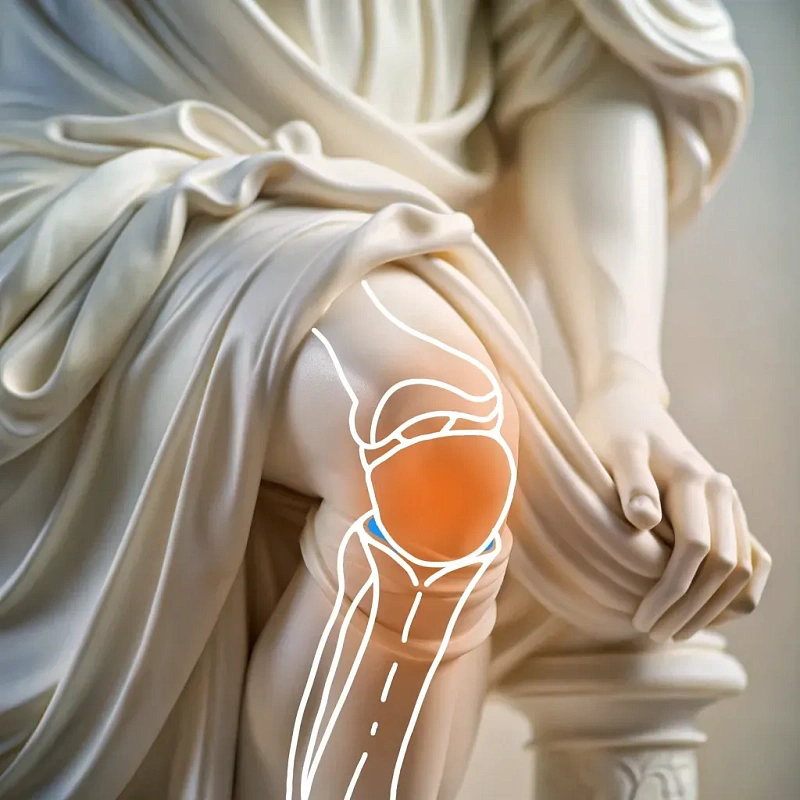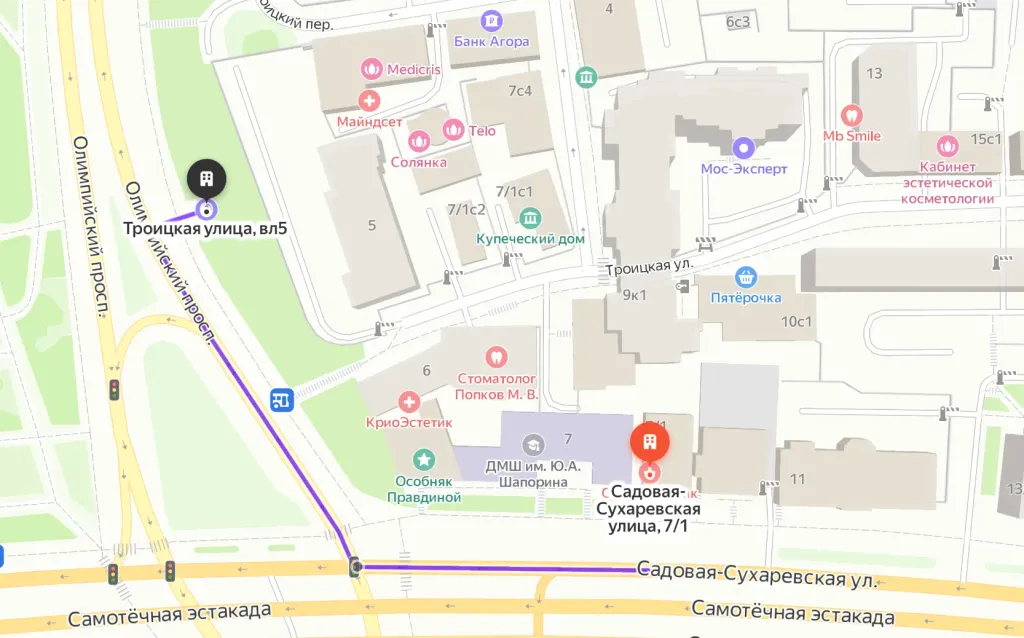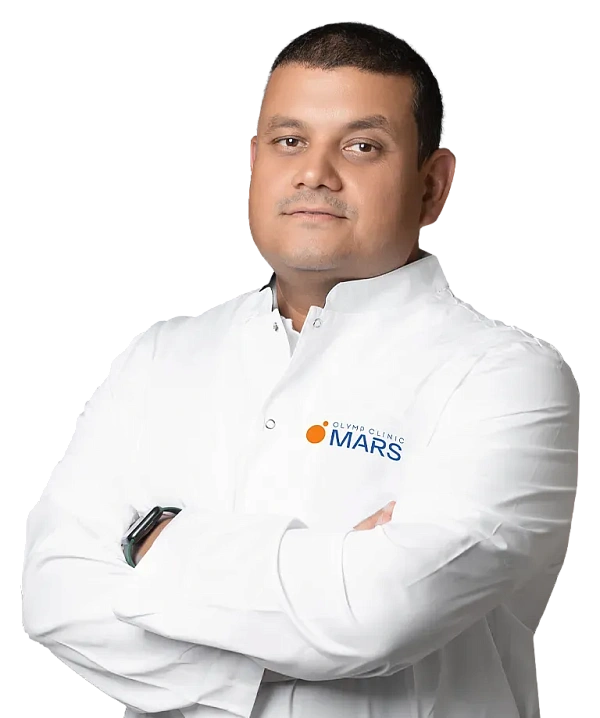Rehabilitation arthroscopy of a large joint
Removal of the infectious process from the joint cavity to restore its normal functioning.

Bacterial infections of the joints, such as septic arthritis, are serious pathologies in which the infection penetrates into the joint cavity, causing inflammation and accumulation of purulent exudate.
Sanation arthroscopy is a key method of treating such infections, allowing minimally traumatic removal of purulent contents and infected tissues, rinsing the joint cavity and preventing further spread of infection. Surgery is necessary when conservative therapy (antibiotics and punctures) cannot cope with the infection. The procedure is performed using an arthroscope, an endoscopic equipment that allows the surgeon to visualize and treat the affected areas of the joint through small incisions.
Blood type and Rh factor. Biochemical research. Coagulogram for the assessment of blood clotting. General blood and urine analysis Radiography and MRI or CT to visualize the condition of bones and surrounding tissues (determined at the initial consultation) Examination for the presence of infectious diseases (HIV, hepatitis). Inoculation for antibiotic sensitivity for the choice of antibacterial therapy. ECG and fluorography. Ultrasound of the veins of the lower extremities. ECHO of KG and EGDS with a long history of the disease, with constant use of painkillers. Consultation with an anesthesiologist and therapist. An endocrinologist if surgery is necessary.
Arthroscopic rehabilitation is performed under anesthesia or conduction anesthesia. The doctor makes several small punctures: one for the insertion of an arthroscope with a video camera and two for surgical instruments. Irrigation fluid is injected into the joint cavity to expand the joint and facilitate access to the affected areas. The surgeon examines the joint cavity, removes purulent masses, infected tissues, and also rinses the cavity with antiseptic solutions. If necessary, pathological neoplasms (for example, osteophytes or cysts) can be removed, as well as cartilage plastic surgery and excision of inflamed synovial membranes.
An arthroscope with a video camera for visualization of the joint. Surgical instruments for removing pus and infected tissues. Irrigation system.
After surgery, the patient stays in the hospital for one to three days, depending on the severity of the infection and the extent of the intervention. In the first days after surgery, it is recommended to raise the operated joint to an elevation to reduce swelling, provide the joint with rest, and conduct early physical exercises under the supervision of a doctor. Full recovery takes from a few weeks to several months.
Benefits
Minimal injury
The operation is performed through small incisions, which reduces tissue damage.
Effective removal of infection
It allows you to remove pus and infected tissues, helps eliminate inflammation.
Fast recovery
Arthroscopy provides a shorter rehabilitation period.
Small scars
Barely noticeable scars remain after the operation.
Frequently Asked Questions
How long does arthroscopic joint rehabilitation last?
When can I return to normal activity?
Can the infection return after surgery?
Didn't find an answer to your question?
You can describe your problem in detail and ask a question to the doctor. He will answer you and help you find a solution
Specialists
Find a SpecialistOrthopedic Trauma Surgeon
Useful information
Olecranon fractures
Olecranon has little or no muscle or other soft tissue protection, making it vulnerable to damage from falls and impacts. The olecranon is the most prominent of the bones forming the elbow joint, specifically the ulna. It attaches to the triceps and, along with the humerus, constitutes the elbow joint, which is responsible for bending and extending the arm. Olecranon fractures vary in complexity. They can be simple, with no displacement of bone fragments, or complex, with damage to the articular surface of the ulna and displacement of fragments by triceps traction. Such fractures cause a loss of extension in the elbow joint, resulting from the disruption of the triceps' connection with the forearm.
Forearm fractures
The forearm is composed of two bones, the radius and ulna, which are connected by a firm interosseous membrane and ligaments at the elbow and wrist joints. Due to their intricate structure, defined by numerous curvatures, these bones constitute five joints. The forearm enables flexion and extension at the elbow and wrist joints, as well as the rotation of the hand (pronation and supination) through the movement of the radius around the ulna.
Rotator cuff rupture
An injury characterized by damage to the tendons that surround the shoulder joint and ensure its mobility.
Impeachment-shoulder joint syndrome
Impingement syndrome (subacromial syndrome) is a condition in which the tendons of the rotator cuff of the shoulder are pinched between the acromion and the head of the humerus, which causes pain and limited movement in the shoulder joint.
Similar referral activities
Arthroscopy of the ankle joint
Ankle arthroscopy is a minimally invasive surgical procedure used to diagnose and treat various diseases and injuries of the ankle joint.
Arthroscopy of the ankle joint
Ankle arthroscopy is a minimally invasive surgical procedure used to diagnose and treat various diseases and injuries of the ankle joint.
Arthroscopy of the knee joint
Knee arthroscopy is a minimally invasive surgical procedure for the diagnosis and treatment of injuries and diseases of the knee joint. It allows examining the joint for damage and eliminating the identified defects.
Arthroscopy of the knee joint
Knee arthroscopy is a minimally invasive surgical procedure for the diagnosis and treatment of injuries and diseases of the knee joint. It allows examining the joint for damage and eliminating the identified defects.
Arthroscopy of the elbow joint
Arthroscopy of the elbow joint is a minimally invasive surgical intervention that allows for accurate diagnosis and simultaneous treatment of joint injuries.
Arthrodesis of the joints of the fingers of the hand
The destruction of the joints of the fingers of the hand is accompanied by pronounced pain and impaired functions. Arthrodesis is a surgical intervention in which the affected joint is completely immobilized, which relieves pain and progression of inflammation.
News & Media
All news and mediaIX ASTAOR International Congress: New Solutions in Sports Medicine
On April 4 and 5, 2025, the IX ASTAOR International Congress was held — a large-scale meeting of specialists in the field of sports traumatology, orthopedics, arthroscopy and rehabilitation. Doctors, nurses, rehabilitologists and other professionals from different cities of Russia and the world came to share their practical experience and discuss current injury treatment technologies.
Olymp Clinic MARS has now become an official partner of Peoples' Friendship University of Russia.
Olymp Clinic MARS extends beyond providing high-quality medical care to serve as a comprehensive scientific and educational platform. The clinic will host training events for students, residents, and postgraduates, while physicians will have the opportunity to enhance their qualifications.
Progressive Arthroscopy: The conference in Voronezh welcomed Professor Andrey Korolev as a distinguished guest.
An interregional scientific and practical conference, entitled "Advanced Arthroscopic Treatment in Traumatology and Orthopedics," was held in Voronezh on November 1-2. The event convened over 120 specialists from across Russia, including traumatologists, orthopedists, and rehabilitation specialists.
Andrey Korolev appreciated the launch of the Crew Dragon spacecraft
The first manned spacecraft in almost a decade has been successfully launched in the United States. According to many experts, the launch of the world's first private spacecraft marks a new era in space exploration.
Slipped, fell, woke up — plaster cast: about fracture treatment
A bone fracture is a common injury that almost everyone has been through. Although human bones are very strong, if the external force is too great, they can break like a plastic ruler when it is bent too much. In the article we will tell you how to act in case of a fracture.
Summer injuries: first aid for bruises, dislocations and sprains
Summer is a time for walking, outdoor activities and sports. The sun and warm weather encourage us to spend more time outside and enjoy nature. But the more we move, the higher the risk of injury becomes. It is not surprising that bruises and dislocations become frequent companions of summer leisure. Of course, in case of serious injuries such as fractures, it is necessary to consult a doctor immediately. But what to do with less significant injuries — minor bruises, sprains with slight swelling and pain? In such cases, you can help yourself and others on your own, knowing the basics of first aid. In this article, we will tell you how to cope with injuries sustained during summer activities and quickly return to your usual lifestyle.
What is the danger of flat feet and how to treat it?
Flat feet are an orthopedic problem in which the shape of the foot changes, its longitudinal and/or transverse arch decreases. Normally, the arches of the foot are responsible for cushioning and even distribution of the load when walking and running. But with flat feet, the foot cannot spring properly, which increases the load on the bones, joints and muscles of the legs.
What should I do if my ligaments are damaged?
Ligament damage is an injury in which there is a violation of the integrity of the fibers that make up the ligaments. Ligaments connect bones to each other, stabilizing joints and preventing their excessive movement. They are made up of collagen fibers, which give them strength and elasticity. But under the external influence of the ligament, the length of the ligaments almost does not change, so the fibers can rupture. Ligaments are damaged due to excessive stretching or sudden movement exceeding their normal amplitude. This can happen if you land incorrectly after a jump, fall, abruptly change the direction of movement or a direct blow to the joint.
How to reach
How to get
From the Belorusskaya metro station of the Zamoskvoretskaya line - exit 4 After exiting the subway, walk through the pedestrian tunnel and climb the stairs. Move towards the railway tracks, go down the stairs immediately after them and walk along the house, then turn right onto 1st Yamskoye Pole Street. At the turn to 3rd Yamsky Pole Street, cross the road at the pedestrian crossing and continue along 1st Yamsky Field Street, after a few buildings on the left you will see Olympus Clinic MARS.
Travel time
9 minutes
Landmark
Olympus Clinic MARS sign
How to get
From the Belorusskaya metro station of the Ring line - exit 2. After exiting the subway, turn left and walk to the pedestrian crossing. Cross the road through two pedestrian crossings and move along the Tverskoy overpass. Go down the stairs immediately after the railway tracks, walk along the house, then turn right onto 1st Yamskoye Pole Street. At the turn to 3rd Yamsky Pole Street, cross the road at the pedestrian crossing and continue along 1st Yamsky Field Street, after a few buildings on the left you will see Olympus Clinic MARS
Travel time
11 minutes
Landmark
Olympus Clinic MARS sign
From the metro station "Tsvetnoy Bulvar"
1 exit to the city, then left to the Garden Ring, at the crossing to the right, crossing the boulevard, one more crossing and at the traffic light to the left. The Olymp Clinic building is located overlooking the Garden Ring to the right of the crossing. Travel time is approximately 9 minutes. Landmark - sign Olymp Clini
From the metro station "Sukharevskaya"
Exit 3 from the metro and 640 meters straight ahead, the clinic will be on the right. Landmark - sign Olymp Clinic
Parking lot map
Exit 3 from the metro and 640 meters straight ahead, the clinic will be on the right. Landmark - sign Olymp Clinic

From Sokol metro station
The last car from the center: follow the signs for Exit 5. From the glass doors to the right and go to the end of the passage. Exit to the city by the steps to the left. After exiting the crossing to the street, go straight along Leningradsky Prospekt to the intersection with Chapaevsky Lane. Next, turn right (onto Chapaevsky Lane) and walk to the Triumph Palace residential complex. Entrance to the territory: through checkpoint No. 1, opposite the Vkusville store, you will need to present your passport. After passing through the checkpoint, go up the stairs to the fountain, opposite it you will see our clinic.
Travel time
10-12 minutes
From the Airport metro station
The first car from the center: follow the Exit 2-3 signs. Turn left out of the glass doors and walk to the end of the passage. After exiting the crossing to the street, go straight along Leningradsky Prospekt to the intersection with Chapaevsky Lane. Next, turn left (onto Chapaevsky Lane) and walk to the Triumph Palace residential complex. Entrance to the territory: through checkpoint No. 1, opposite the Vkusville store, you will need to present your passport. After passing through the checkpoint, go up the stairs to the fountain, opposite it you will see our clinic.
Travel time
12-15 minutes
How to get
Entry to the territory is prohibited, but there are free city parking lots around the Triumph Palace residential complex, where you can easily find a place for your car. Free parking area:




